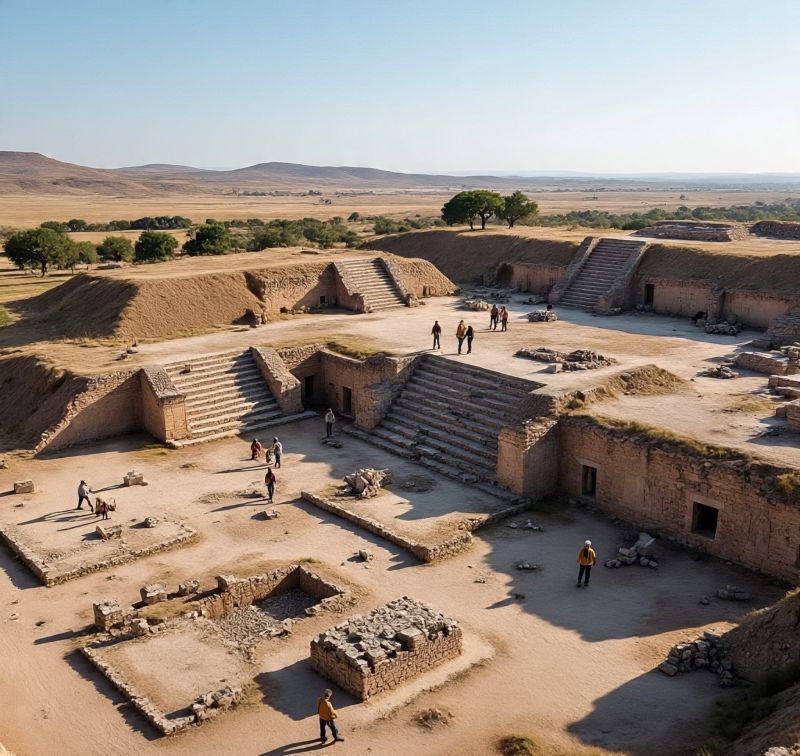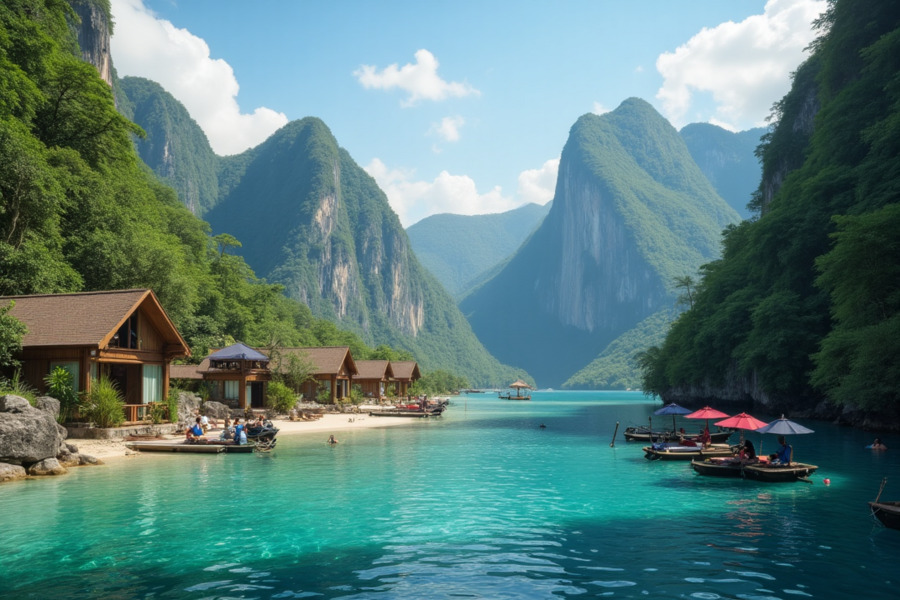≡-From Peru to Mexico six Mysterious Ancient Wonders Tourists Can’t Stop Visiting Including the Nazca Lines and Pyramid of the Sun – Viral of Today
<> Viral of Today <>
Home » America Travel News » From Peru to Mexico six Mysterious Ancient Wonders Tourists Can’t Stop Visiting Including the Nazca Lines and Pyramid of the Sun Published on
August 27, 2025The wonders of the Americas, from the Nazca Lines in Peru to the monumental Pyramid of the Sun in Mexico, have long been seen as more than architectural feats. These remarkable creations revealed how ancient societies balanced faith, political authority, and environmental challenges to sustain thriving communities. Observers emphasized that such monuments continue to stand as timeless reminders of human resilience, cultural innovation, and the leadership that shaped entire civilizations.For today’s travelers, exploring places like Copán in Honduras, Cahokia near the Mississippi River, or Tiwanaku by Lake Titicaca is not just sightseeing. It is an opportunity to immerse themselves in stories of survival, ingenuity, and creativity that predated modern technology. Analysts stressed that these landmarks should not be viewed as frozen relics but as guiding examples for heritage-based tourism. By safeguarding these legacies, the travel industry strengthens global cultural exchange, promotes sustainable tourism, and nurtures deeper connections between visitors and history.Global Implications for Travel and HeritageExperts suggested that the ancient landmarks of the Americas had profound implications for global tourism. They stressed that these sites were not only central to the memory of civilizations but also vital for shaping the travel industry’s future. Analysts claimed that the preservation of places like the Cliff Palace in Mesa Verde, the Nazca Lines in Peru, and the Pyramid of the Sun near Mexico City created opportunities for travelers to engage with history while generating significant cultural and economic benefits for local populations.Key implications were highlighted:A growing demand for sustainable tourism that reduces environmental impact.Increased interest in immersive cultural storytelling, where travelers seek meaning beyond sightseeing.Opportunities for nations to strengthen their global identity by showcasing their heritage.Specialists stated that the trend toward authentic travel experiences was reshaping global tourism. They explained that visitors no longer simply wanted to view monuments; they wanted to understand the societies that built them, the values they represented, and the mysteries they left behind. These developments, analysts argued, ensured that heritage tourism was evolving into a deeper and more meaningful industry that blended education, cultural preservation, and travel experiences.Pyramid of the Sun: Monument of TeotihuacanObservers stated that on the outskirts of Mexico City, the monumental Pyramid of the Sun dominated the ancient landscape of Teotihuacan. Constructed around 200 AD, this enormous structure was reported to rise over 200 feet high and stretch nearly 700 feet wide, ranking it among the most massive pyramids of the Americas.Excavations beneath the pyramid uncovered intricate tunnels and underground chambers filled with offerings and remains, leading scholars to argue that the structure likely served dual purposes as both a religious shrine and a possible funerary site. They emphasized that the exact identity of its builders remained unknown, while the reasons behind the city’s decline by the 7th century continued to puzzle historians.Travelers were said to be deeply fascinated by this site, as it was both a symbol of architectural mastery and a profound mystery of human history. Analysts explained that its global popularity made it one of the most important tourist attractions in the Americas, proving how ancient creativity continued to drive modern cultural tourism.Nazca Lines: Designs Across the DesertIt was reported that across the arid plains of Peru, the enigmatic Nazca Lines stretched for nearly 200 square miles. Created over 2,500 years ago, these giant geoglyphs displayed intricate depictions of animals such as hummingbirds, monkeys, and whales, alongside abstract spirals and geometric figures.The true meaning of these immense designs was said to remain unsolved. Some researchers suggested they had astronomical purposes, possibly aligning with celestial events, while others believed they may have been ritual markers intended to summon rain in the harsh desert climate. Regardless of their origin, they were widely recognized as an extraordinary achievement of human imagination and determination.For today’s travelers, the Nazca Lines were described as one of the most spectacular aerial wonders in the world. Specialists emphasized that their visibility from the sky offered a unique travel experience, unlike any other, and continued to attract global visitors eager to witness the sheer scale of ancient ingenuity.Cliff Palace: A Community in the CliffsReports described how in Mesa Verde, Colorado, the Cliff Palace stood as the most significant dwelling ever built by the Ancestral Puebloans. Constructed in the 13th century, this remarkable cliffside settlement was said to contain around 150 rooms and 23 ceremonial kivas, housing nearly 100 residents.Scholars believed that its occupation was relatively short, with prolonged drought conditions likely forcing its people to leave. Yet, even in its brief existence, the Cliff Palace was interpreted as a profound symbol of adaptation and community resilience.Travelers visiting Mesa Verde were thought to gain an extraordinary glimpse into the daily life of a community that thrived against natural challenges. Specialists remarked that the site illustrated how people could establish vibrant communities within seemingly inhospitable landscapes, providing both historical insight and inspiration for modern visitors.Tiwanaku: Precision in StoneExperts suggested that near the shores of Lake Titicaca in Bolivia, the city of Tiwanaku represented one of the world’s most remarkable examples of stone engineering. Builders of the site were reported to have shaped immense blocks, some weighing more than 100 tons, and fitted them together with flawless precision without the use of mortar.Prominent structures such as the Akapana pyramid and the Gate of the Sun were described as both religious monuments and political symbols. Analysts argued that these works demonstrated how Tiwanaku had flourished as a spiritual and political hub in its time.Although the city declined by the end of the first millennium, debate continued among scholars about whether climate change or disrupted trade networks had caused its fall. Today, visitors were said to marvel at the engineering skills of the builders, finding themselves amazed by a civilization that managed such perfection long before modern machinery existed.Cahokia: A City That Rivaled Medieval LondonCommentators recounted that near present-day St. Louis, Missouri, across the Mississippi River, the city of Cahokia thrived nearly 1,000 years ago. It was described as one of the most advanced urban centers of the Mississippian culture. Scholars observed that at its height, Cahokia’s population might have rivaled that of medieval London, making it one of the largest and most complex cities of North America.Excavations revealed more than 120 earthen mounds, including the massive Monks Mound, which spanned over 14 acres. This structure was said to have functioned as a central hub for both political authority and ceremonial life. Archaeologists noted evidence of solar calendars and complex rituals, suggesting a society deeply intertwined with cosmic order. Accounts even mentioned the possibility of human sacrifice, underlining the close connection between spirituality and governance.By the 14th century, however, Cahokia had been abandoned. The exact reasons remained uncertain, though theories pointed to environmental pressures, resource shortages, or social unrest. Despite its disappearance, travelers and historians were said to continue being fascinated by its scale and mystery, regarding it as a lasting reminder of North America’s pre-Columbian achievements.Copán: The Written Story of the MayaObservers explained that in western Honduras, the city of Copán flourished during the 5th century under the rule of a powerful dynasty of kings. This city was described as a major hub of the Maya civilization, celebrated for its intricate artistry and monumental stonework.Among its most treasured remains was the Hieroglyphic Stairway, which included over 2,000 glyphs. This stairway was considered one of the most extensive written records of Maya rulers, beliefs, and political life.By the 9th century, however, Copán entered decline. Scholars speculated that a combination of environmental stress, population growth, and political upheaval likely contributed to its collapse. Despite its downfall, the site remained an invaluable archive of Maya history. Visitors were said to be captivated by its inscriptions and monuments, which continued to offer rare insights into one of the most influential civilizations of the Americas.A Journey Into Mystery and HeritageCommentators concluded that Mexico and the greater Americas were home to some of the world’s most astonishing ancient wonders, each reflecting not just architectural skill but also cultural resilience and human determination. From the Pyramid of the Sun in Teotihuacan to the Cliff Palace in Mesa Verde, these monuments were said to highlight mastery in astronomy, urban planning, and engineering, achieved centuries before modern technology existed.Scholars emphasized that beyond their grandeur, these sites raised timeless questions about faith, leadership, and survival. They were regarded as symbols of creativity and resilience, inspiring both archaeologists and travelers across generations.Analysts believed that as modern tourism evolved, these wonders of the Americas would remain central in shaping global heritage travel. By offering authentic cultural experiences, they were said to link the past with the present, ensuring that the legacies of Copán, Cahokia, Tiwanaku, Nazca, Mesa Verde, and Teotihuacan would continue to influence both cultural understanding and the travel industry for centuries to come.
This information will surprise you!
See also
- Read until the end to discover everything.
- Important information you need to know.
- Interesting facts and helpful tips.
Conclusion
Did you enjoy the news? Keep following us daily!













